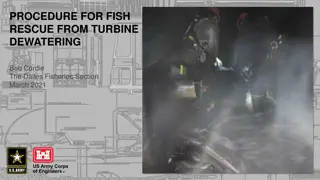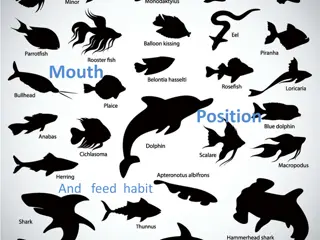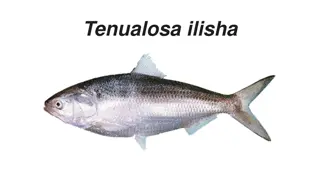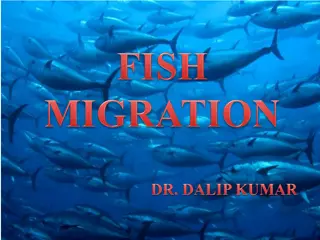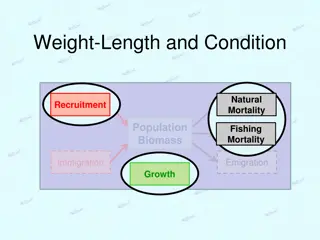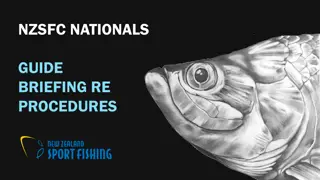A Fascinating Dive into the World of Fish Taxonomy - Ichthyology Lesson Highlights
Explore the intriguing world of fish taxonomy through a captivating Ichthyology lesson at Shanghai Ocean University in Fall 2020. Delve into the diverse families such as Percidae, Xiphiidae, Scombridae, Pleuronectidae, and Tetraodontidae, discovering unique features and characteristics of fish species ranging from perches and billfishes to tunas, mackerels, flounders, and puffers. Uncover the beauty and complexity of marine life as you learn about remarkable fish adaptations and behaviors.
Download Presentation

Please find below an Image/Link to download the presentation.
The content on the website is provided AS IS for your information and personal use only. It may not be sold, licensed, or shared on other websites without obtaining consent from the author. Download presentation by click this link. If you encounter any issues during the download, it is possible that the publisher has removed the file from their server.
E N D
Presentation Transcript
Ichthyology Shanghai Ocean University Fall, 2020 Lesson 9 Taxonomy III
Teleosts III Silversides to Perches
Family Percidae (perches and darters) -One of the most speciose fish families in North America -Elongate body -Spiny, divided dorsal fin -190 species in North America, but 155 are darters yellow perch -19 in Wisconsin; 15 are darters -darters are benthic; lack swimbladder -Other prominent members of Percidae -walleye -sauger -zander -ruffe
Family Xiphiidae (billfishes) Hydrodynamic body form Streamlined open ocean predators Some of the fastest fish in the ocean Common feature: long, pointed rostrum -Prized gamefish; featured by Hemingway -Blue marlin can exceed 1000 lbs -Hydrodynamic body form -Streamlined open ocean predators -Some of the fastest fish in the ocean -Common feature: long, pointed rostrum -Prized gamefish; featured by Hemingway -Blue marlin can exceed 1000 lbs More info on the blue marlin (link)
Family Scombridae (tunas and mackerels) -The perfect hydrodynamic body form. (thunniform swimmers) -narrow caudal peduncle -broad, but shallow tail -swept back fins -tremendous muscle mass -can even generate some body heat -Global stocks plummeting!!! Bluefin tuna sells for $396,000 (link) Bluefin tuna sells for $396,000 (link) Bluefin Tuna not ruled endangered (link) - 2011
Scomberomorus niphonius Pneumatophorus japonicus
Family Pleuronectidae (right-eye flounders) -Several families of flatfishes this is just one -All exhibit unusual development resulting in both eyes on one side of body; lie flat on bottom on opposite side -Important food fish sole -Other flatfishes include sole, halibut, and other flounders 693 lb halibut
Family Tetraodontidae (puffers) - Tetra = 4; dont = teeth -Tetraodontids have four teeth flattened into crushing plates -Other prominent/unusual characteristics include spiny covering ability to puff up by gulping in water or air independent eye movement
Family Molidae (ocean sunfishes) -Largest bony fish; adults up to 5000 lbs -Very unusual body form; depth up to twice that of length -No caudal fin (i.e., no tail) -Swims by flapping LONG dorsal and anal fins -Pelagic wanderer; feeds on jellyfish -Recent conservation concerns: bycatch and finning Fish Guys!
Acanthuroidei Siganus fuscessens Trichiuroidei Trichiurus haumela (cutlassfishes) Stromateoidei Pampus argenteus
Sinipercidae Siniperca undulata (Chinese perch) Serranidae Epinephelus awoara (grouper)
Sciaenidae Pseudosciaena croea Psedosciaena polyactis (Yellow croaker)
Anabantoidei Anabas scandens Macropodus chinensis Channidae Channa asiatica Mastacembeloidei Mastacembelus aculeatus
Trends during teleostean phylogeny Trends during teleostean phylogeny
Trends during teleostean phylogeny Trends in five areas can be readily linked to functional improvements that contributed to teleostean success reduction in bony elements, repositioning and elaboration of the dorsal fin, change in placement and function of paired fins, structural modifications to and interaction between the caudal fin and gas bladder, and jaw improvements.
Presentation for next week (Dec 6) Compare R-selected vs. K-selected reproduction strategy, give some examples. Introduce the phenomenon of sex change in fishes, give examples and explain how it evolved. Describe three major differences between the sexes in fish, and give examples. Describe different types of parental care in fishes.
HWK Homework 8.docx due on Dec 6 No late hand-in will be graded Read Chapter 14&15
Have a nice week! My fishing trips

















